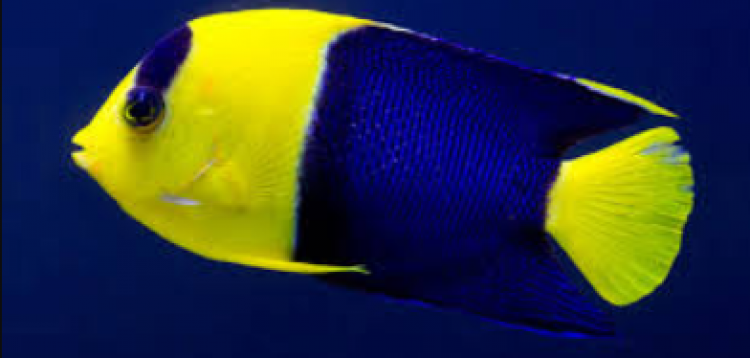- Name:
Bellus Angelfish
(View AKA's) - Family: Pomacanthidae
- Species: Angel Large
- Scientific Name: Genicanthus bellus


General info about Bellus Angelfish
The Bellus Angelfish is one of the few angelfish displaying sexual dimorphism. The male is an iridescent pale white and blue, with the lower half of the body and anal fin highlighted by long, horizontal blue stripes and one, yellow to orange stripe extending toward the caudal fin and edging the dorsal fin. The female is an iridescent pale white and blue and black with a yellow/orange dorsal fin and lateral stripe running from gills to tail. Bellus Angelfish are best housed as a male-female pair or small harem of one male and few females in a large aquarium and are ideal candidates for the deep-water reef aquarium. Acclimation will be facilitated by a dimly-lit tank, but these fishes seem to adapt well to the intense lighting in most modern reef aquariums. The tank should have multiple hiding places and live rock for grazing. Do not keep two males in the same tank as fighting will ensue.
Bellus Angelfish Diet & Nutrition
Bellus angelfish are planktivores, feeding mainly on zooplankton and marine algae. It has also been observed to consume benthic invertebrates such as polychaetes and bryozoans and algae. In captivity, they will accept frozen and prepared food composed of Spirulina, brine shrimp, mysis, and shellfish.
Determining Sex of Bellus Angelfish
Sexual dimorphism is observed among Bellus angelfish. Female fish are white with black and blue stripes with a broad black diagonal band bounded by white from above the gill cover to the lower caudal lobe, an elongate blue patch on the lower side, a broad black bar through the eye, a black dorsal fin with a red submarginal band and a black outer upper caudal fin lobe giving a scissor-tail appearance. Male Bellus angelfish are pale greyish with yellow dorsal fin, a yellow horizontal stripe along the lateral line, and blue margins on the fins.
The species are also protogynous sequential hermaphrodites which means they are born females and can change into males when the need arrives.
Breeding & Spawning Bellus Angelfish
Breeding and spawning for Genicanthus bellus has been done successfully in home aquariums. They are pelagic spawners, the male and female rise up into the water column with the male lining up his vent with the female and then they release sperm and eggs for external fertilization. The challenge in breeding is the rearing of successful larvae into maturity.
Some aquarists have reported a hybridization of the Bellus angelfish with the Lamarck's angelfish Genicanthus lamarck
Common Diseases with Bellus Angelfish
Bellus angelfish are prone to infection due to poor needling practices and swimming with their head down. Infections from common bacterial diseases includes Cotton wool disease, Vibrio bacterial disease, and Fish tubercolosis.
Bellus Angelfish Origin
This species is found in reefs in the Western Pacific and Eastern Indian Oceans. Bellus angelfishes are found distributed in Tahiti, Guam, Palau, Tonga, Cook Islands, the Marshall Islands, Philippines, Okinawa in Japan, southern Indonesia, and in Cocos-Keeling Atoll in Australia.
Caution with Bellus Angelfish
They are known peaceful tank inhabitants, except when being housed together with another angelfish. Also, when adding multiple angelfish, it is best to add just one male individual in the tank system to avoid fighting in the tank.
They are known to pick on other species with the same feeding preference such as wreckfish (Pseudanthias spp.), fairy and flasher wrasses, and fire fish.
This species is also known to jump out of an open aquaria.
Acclimating Bellus Angelfish
It is recommended that the Bellus angelfish is to be placed in a 120 gallon tank with plenty of hiding spaces for it to live comfortably, and avoid becoming aggressive.
To acclimatize it in the tank, it is suggested to dim the light first and gradually increase it to normal.
Original Detail
| Name | Species | Family | Scientific Name | More Detail | Added by |
|---|---|---|---|---|---|
| Bellus Angelfish | Angel Large | Pomacanthidae | Genicanthus bellus | The Bellus Angelfish is one of the few angelfish displaying sexual dimorphism. The male is an iridescent pale white and blue, with the lower half of the body and anal fin highlighted by long, horizontal blue stripes and one, yellow to orange stripe extending toward the caudal fin and edging the dorsal fin. The female is an iridescent pale white and blue and black with a yellow/orange dorsal fin and lateral stripe running from gills to tail. Bellus Angelfish are best housed as a male-female pair or small harem of one male and few females in a large aquarium and are ideal candidates for the deep-water reef aquarium. Acclimation will be facilitated by a dimly-lit tank, but these fishes seem to adapt well to the intense lighting in most modern reef aquariums. The tank should have multiple hiding places and live rock for grazing. Do not keep two males in the same tank as fighting will ensue. |
PalaciosAn |
Changed by users
| Submitted Date | Submitted By | Status | Action |
|---|



